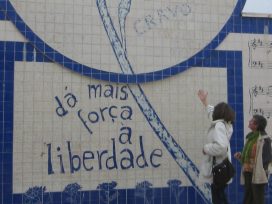On 11 November 2008, in the framework of operation Taiga, 150 police encircled the small village of Tarnac, in Corrèze (south west France). Simultaneously, evidence was seized in Rouen, Paris, Limoges, and Metz. The arrest of the young people was above all a spectacle to incite fear. Their arrest was said to be in connection with the sabotage of the tracks of the SNCF, which caused, on November 8, delays for certain TGVs on the Paris-Lille line. These acts, which brought down several overhead cables, were characterized as “terrorist”, despite the fact that they never, at any moment, put any human lives in danger. The prosecution, which says it possesses several clues, recognizes that it has no material evidence or proof.
It is the character profile of the arrested youths that justifies their being held for questioning. They were arrested because “they used radical language and had relations with foreign groups”, and that a number of them “participated on a regular basis in political demonstrations”, for example, in “marches held in opposition to the Edvige data filing system and against the reinforcement of measures against immigration”. As for their domicile, it was described as “a meeting place, for indoctrination, a headquarters for violent action”.
While being accused of constituting a “hard core cell that had armed struggle as its purpose”, they were rapidly be freed, some conditionally so, others on house arrest. Only the “chief” and his companion were held in custody. On 26 December the appeal court in Paris, at the request of the prosecution, cancelled an order that Julien Coupat be released. The request for the release of his companion had been refused earlier.
The discourse of the government illustrates a kind of double displacement: first, ordinary acts of sabotage, such as those one might find in any social movement, are qualified as “terrorist”; second, the youths of Tarnac are blamed for these acts, despite the fact that the police admit to the absence of any material element of proof. The image of terrorism construed by the state creates a reality that substitutes the facts. The facts are not denied, but they are denied any explanatory capacity. Acts of sabotage cannot be other than the acts of persons designated as terrorists. The act of naming overrides any procedure of objective evaluation.
The absence of material proof that would permit the persecution of the incriminated persons is not denied, yet the necessary prevalence of facts is overturned in the interests of the primacy of the image constructed by the state. The position of the minister of the interior, Michèle Alliot-Marie, is particularly interesting: “They have adopted underground methods. They never use mobile telephones, and live in areas where it is very difficult for the police to gather information without being spotted. They have established friendly relations with the in the villagers of Tarnac, who can warn them of the presence of strangers.” Yet Alliot-Marie admits that “there have been no indications of attacks against persons”.
These declarations nicely sum up the affair. What makes these young people terrorists is their way of life, the fact that they attempt to escape the economic machine, and that they do not adopt a “pro-active”, submissive attitude with respect to procedures of control. Not to have a mobile telephone is evidence of terrorist intentions. To re-establish social ties is also incriminating, since it constructs a protective shield against the deployment of unrestricted power by the state.
In the absence of any convincing material elements of proof, the reference to acts cannot be rationally assimilated; a phase of aberration is induced, a reconstruction of reality with the image of terrorism as support.
This process is equally visible in the police reports, which utilize, from a purely semantic point of view, an entirely phantasmagorical reconstruction of reality. Thus, as material proof establishing the culpability of the accused, the police speak of “documents noting the times of arrival and departure of trains from the stations, village by village”. An SNCF timetable thus becomes an incriminating document and its possession necessarily implies participation in material destruction of railway equipment.
The staging of the arrest and the bringing of charges against the “autonomous youth of Tarnac” is a phenomenon that reveals a profound mutation of the symbolic order of society.
The state has the chance to create a new reality, a virtual reality that does not suppress, but rather supplants facts. The weakness of social movements, the failure of the symbolic function, explain the absence of brakes on the domination of the state, which appears in the guise of a maternal image.
Where a social order reveals itself to be contradictory, a psychotic structure takes its place, an order that suppresses all conflict, suppresses all possibility of confrontation with reality.
This article originally appeared in L’Humanité in English. A longer version of the article is published in French in Multitudes 35 (2009).






